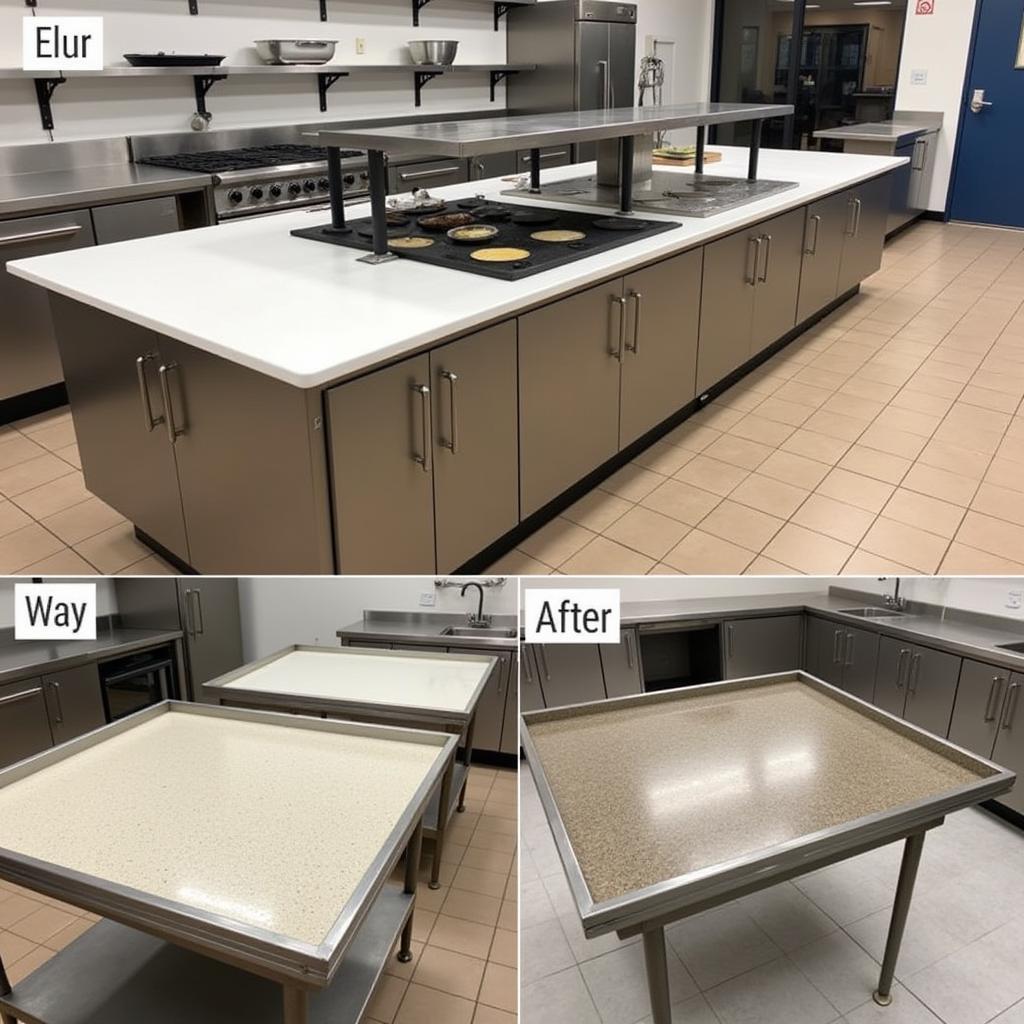Food Grade Epoxy is a term that often sparks curiosity and questions, especially for those interested in DIY projects or working with food-contact surfaces. This guide aims to demystify food grade epoxy, exploring its properties, applications, safety considerations, and more. We’ll delve into what makes an epoxy “food safe,” the regulations surrounding its use, and how to choose the right product for your needs.
What Exactly is Food Grade Epoxy?
Food grade epoxy refers to a specific type of epoxy resin that, once fully cured, is deemed safe for incidental food contact. This doesn’t mean you should be eating the epoxy itself, but rather that it won’t leach harmful chemicals into food that briefly touches the cured surface. Think cutting boards, countertops, or even coatings for containers. It’s crucial to understand that not all epoxies are food grade. Some contain bisphenol A (BPA), a chemical that can disrupt hormones and pose health risks. Choosing a certified food grade epoxy is essential for ensuring safety.
One common application is food safe flooring. Epoxy flooring provides a durable and hygienic solution for food processing areas, ensuring easy cleaning and preventing bacterial growth.
Food grade epoxy offers exceptional durability and resistance to moisture, chemicals, and temperature fluctuations, making it a popular choice for a variety of applications. However, it’s important to note that “food grade” doesn’t necessarily mean “food safe” in all scenarios. The specific formulation and curing process play a critical role in determining the final safety of the cured epoxy surface.
 Food Grade Epoxy Resin Applications in Food Industry
Food Grade Epoxy Resin Applications in Food Industry
Key Properties and Benefits of Food Grade Epoxy
Food grade epoxy, when fully cured according to manufacturer instructions, offers a unique combination of properties that make it ideal for specific applications:
- Non-Toxicity: After proper curing, food grade epoxy becomes inert and doesn’t leach harmful substances into food.
- Durability: It’s highly resistant to scratches, impacts, and wear and tear.
- Moisture Resistance: This makes it perfect for applications in wet or humid environments.
- Chemical Resistance: It can withstand exposure to many common household chemicals and cleaning agents.
- Temperature Resistance: Certain food-grade epoxies can tolerate high temperatures, making them suitable for use in kitchens.
Using food safe modge podge is another way to ensure the safety of your food-contact projects. This specialized sealant provides a protective barrier while maintaining food-safe standards.
Is Food Grade Epoxy Truly Safe?
The safety of food grade epoxy hinges on proper curing. Uncured or improperly cured epoxy can leach harmful chemicals, posing health risks. Always follow the manufacturer’s instructions meticulously. Look for certifications like FDA compliance to ensure the product meets safety standards.
How can I tell if an epoxy is food safe?
Look for certifications and explicit statements from the manufacturer confirming FDA compliance for food contact.
What happens if I don’t cure the epoxy properly?
Improper curing can result in leaching of harmful chemicals into food, compromising safety.
 Microscopic View of Cured Food Grade Epoxy Surface
Microscopic View of Cured Food Grade Epoxy Surface
Choosing the Right Food Grade Epoxy
Selecting the correct food grade epoxy resin requires careful consideration of its intended use. Different formulations exist, each optimized for specific applications. Consider factors like temperature resistance, viscosity, and curing time when making your choice.
For metal projects, using food safe metal glue is crucial for ensuring the safety of food that comes into contact with the bonded surfaces.
What factors should I consider when choosing food grade epoxy?
Consider the intended application, temperature resistance, viscosity, and curing time.
Where can I purchase certified food grade epoxy?
Reputable suppliers and online retailers specializing in epoxy products are good sources.
Food Grade Epoxy vs. Food Grade Powder Coating
While both offer protective finishes, they differ in application and properties. Food grade powder coating is applied electrostatically and then cured under heat, creating a thick, durable layer. Food grade epoxy is typically applied as a liquid and cures at room temperature. Choosing between the two depends on the specific project requirements.
Conclusion
Food grade epoxy provides a versatile and durable solution for numerous applications where incidental food contact may occur. Understanding its properties, safety considerations, and proper application is crucial for ensuring both functionality and peace of mind. Remember to prioritize certified products and adhere strictly to manufacturer guidelines for optimal results and safe use. Choosing the right food grade epoxy allows you to create durable and safe surfaces for various projects.
FAQ
- What is the difference between food safe and food grade?
- How long does food grade epoxy take to cure?
- Can food grade epoxy be used outdoors?
- How do I clean surfaces coated with food grade epoxy?
- Is food grade epoxy resistant to UV light?
- Can I use food grade epoxy for children’s toys?
- What are the alternatives to food grade epoxy?
Common Scenarios and Questions
- Scenario: Creating a DIY serving tray. Question: Which food grade epoxy is best for this application?
- Scenario: Repairing a chipped countertop. Question: Can food grade epoxy be used for repairs?
- Scenario: Coating a wooden cutting board. Question: How many coats of food grade epoxy are needed?
Further Exploration
For more information on related topics, you can explore articles on food safe sealants and coatings on our website.
For any assistance, please contact us at Phone: 02437655121, Email: minacones@gmail.com or visit our address: 3PGH+8R9, ĐT70A, thôn Trung, Bắc Từ Liêm, Hà Nội, Việt Nam. We have a 24/7 customer service team.